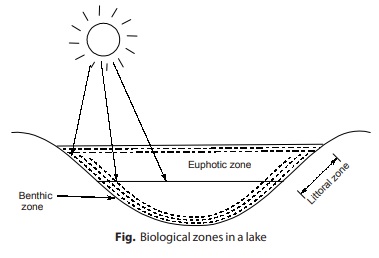Biological Zones in Lakes
Lakes have been found to exhibit distinct zone of biological activity, largely determined by the availability of light and oxygen the most important biological zones are:
Biological Zones are:
(i) Euphotic zone
(ii) Littoral zone
(iii) Benthic zone
(i) Euphotic zone:
The upper layer of lake water through which sunlight can penetrate, is called the euphotic zone. All plant growth occurs in this zone. The depth of the euphotic zone is reduced by the turbidity which block sunlight penetration. The depth of the euphotic zone can be measured by a device called the Secchi disk.
(ii) Littoral Zone:
The shallow water near the shore, in which rooted plants grow, is called the littoral zone. The extent of the littoral zone depends on the slope of the lake bottom and the depth of the euphotic zone. The littoral zone cannot extend deeper than the euphotic zone.
(iii) Benthic zone:
The bottom sediments in a lake comprises the benthic zone. Living organism when die settles down to the bottom which are decomposed by bacteria present in benthic zone.
PRODUCTIVITY OF LAKE
The productivity of a lake is defined as a measure of its ability to support a food chain.
• Since the algae forms the base of this food chain. The higher algal growth leads to decreased water quality.
• Depending upon the increasing level of its productivity, the lakes may be classified as
(i) Oligotrophic lake
(ii) Mesotrophic lake
(iii) Eutrophic lake
(iv) Senescent lake
(i) Oligotrophic Lake
- Oligotrophic lakes have a low level of productivity due to a severely limited supply of nutrients to support algal growth.
- The water of such a lake is, therefore, clear enough as to make its bottom visible upto considerable depth.
- In such a case, the euphotic zone often extends into the hypolimnion zone, which is aerobic.
- Oligotrophic lakes, supports cold water game fish.
(ii) Mesotrophic Lake
- The lakes having medium productivity levels, with medium growth of algae and turbidity, are usually classified as mesotrophic lakes.
- Hypolimnion zone remains aerobic although substantial depletion of oxygen occurs.
(iii) Eutrophic Lakes
- Eutrophic lakes do have a high level of productivity, because of an abundant supply of algal nutrients.
- Euphotic zone will partially extent into epilimnion.
- Hypolimnion zone is anaerobic.
(iv) Senescent Lake
- These are very old shallow lakes, having thick organic sediment deposits at their bottoms.
- Rooted water plants abundantly grow in such shallow ponds, which ultimately become marshes.
Eutrophication of Lakes
- It is a natural process under which lakes get infested with algae and silt up gradually to become shallower and more productive through the entry and cycling of nutrients like carbon, nitrogen and phosphorus.
- The initial clear water of oligotrophic lakes, therefore, gradually turns into mesotrophic, eutrophic and senescent stages, due to continues entry of silt and nutrients.
- Disintegration of rocks produces phosphorus, increased phosphorus in lake water accelerate eutrophication of lake and this is called cultural eutrophication.
- Once phosphorus is mixed in lake, only solution is to add lime and to dredge out the sediment at the bottom of lake.
- To avoid eutrophication, lakes should not be used for disposal of even the treated sewage.
<< Previous | Next >>
Must Read: What is Environmental Engineering?

